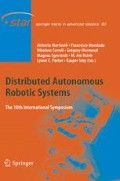Abstract
Shallow seas are extremely difficult environments for autonomous underwater profiling floats. These robots possess no thrusters and only one actuator for their buoyancy control, and are thus entirely dependent on sea currents for lateral motion. As a further restriction, underwater acoustic communication is very limited. Taking into account these challenges, a novel co-operative underwater multi-robot system has been designed and implemented for use in shallow waters. A coordination strategy and a localization method have been developed and tested using a detailed simulation of the Baltic Sea. These methods allow the system to operate safely and to map underwater currents and other environmental variables with relatively high accuracy.
Access this chapter
Tax calculation will be finalised at checkout
Purchases are for personal use only
Preview
Unable to display preview. Download preview PDF.
References
Argo Steering Team, On the design and Implementation of Argo - an initial plan for the global array of profiling floats. International CLIVAR Project Office Report, vol. 21 (1998)
Arnold, J., Bean, N., Kraetzl, M., Roughan, M.: Node localisation in wireless ad hoc networks. In: Proc. ICON 2007, pp. 1–6 (2007), doi:10.1109/ICON.2007.4444052
Aro, E., Vainio, M., Hu, Z., Halme, A.: Diving in density: Controlling the depth of a profiling float in coastal waters. In: Proc. IASTED-CA 2010 (2010)
Biswas, P., Ye, Y.: Semidefinite programming for ad hoc wireless sensor network localization. In: Proc. IPSN 2004, pp. 46–54. ACM (2004), doi:10.1145/984622.984630
Chandrasekhar, V., Seah, W.K., Choo, Y.S., Ee, H.V.: Localization in underwater sensor networks: survey and challenges. In: Proc. WUWNet 2006, pp. 33–40. ACM (2006), doi:10.1145/1161039.1161047
Davis, R.E., Sherman, J.T., Dufour, J.: Profiling alaces and other advances in autonomous subsurface floats. Journal of Atmospheric and Oceanic Technology 18(6), 982–993 (2001)
Erol, M., Vieira, L.F.M., Gerla, M.: Localization with dive’n’rise (dnr) beacons for underwater acoustic sensor networks. In: Proc. WuWNet 2007, pp. 97–100. ACM (2007), doi:10.1145/1287812.1287833
Fofonoff, N.P., Millard, R.C.: Algorithms for computation of fundamental properties of seawater. UNESCO Technical papers in marine science, vol. 44 (1983)
Garcia, J.: Positioning of sensors in underwater acoustic networks. In: Proc. OCEANS 2005, vol. 3, pp. 2088–2092 (2005), doi:10.1109/OCEANS.2005.1640068
Hela, I.: The sound channel of the baltic sea. Geophysica 5(4), 153 (1958)
Howard, A., Mataric, M., Sukhatme, G.: Relaxation on a mesh: a formalism for generalized localization. In: Proc. IROS 2001, vol. 2, pp. 1055–1060 (2001), doi:10.1109/IROS.2001.976308
Hu, Z., Aro, E., Stipa, T., Vainio, M., Halme, A.: Localization in an autonomous underwater multi-robot system design for coastal area monitoring. In: Proc. ICINCO 2010. INSTICC Press (2010)
McFarland, D., Honary, E.: Flock distortion: A new approach in mapping environmental variables in deep water. Robotica 21(4), 365–383 (2003), doi:10.1017/S0263574703004958
Moore, D., Leonard, J., Rus, D., Teller, S.: Robust distributed network localization with noisy range measurements. In: Proc. SenSys 2004, pp. 50–61. ACM (2004), doi:10.1145/1031495.1031502
Moses, R.L., Krishnamurthy, D., Patterson, R.: A self-localization method for wireless sensor networks. EURASIP Journal on Applied Signal Processing 4, 348–358 (2003), doi:10.1155/S1110865703212063
Priyantha, N.B., Balakrishnan, H., Demaine, E., Teller, S.: Anchor-free distributed localization in sensor networks. Tech. Rep. 892, MIT Laboratory for Computer Science (2003)
Sanford, T., Dunlap, J., Carlson, J., Webb, D., Girton, J.: Autonomous velocity and density profiler: Em-apex. In: Proc. CMTC 2008, pp. 152–156 (2005), doi:10.1109/CCM.2005.1506361
Stipa, T., et al.: Short-term effects of nutrient reductions in the North Sea and the Baltic Sea as seen by an ensemble of numerical models, MERI, Report series of the Finnish Institute of Marine Research, vol. 49 (2003)
Vadov, R.: The discovery of the underwater sound channel, experimental studies, and regional differences. Acoustical Physics 53, 268–281 (2007), doi:10.1134/S1063771007030049
Vainio, M., et al.: Autonomous underwater multiprobe system for coastal area/shallow water monitoring (swarm). In: Proc. Eurocean 2004, pp. 407–408 (2004)
Author information
Authors and Affiliations
Corresponding author
Editor information
Editors and Affiliations
Rights and permissions
Copyright information
© 2013 Springer-Verlag Berlin Heidelberg
About this chapter
Cite this chapter
Aro, E., Hu, Z., Vainio, M., Halme, A. (2013). Coordinating a Group of Autonomous Robotic Floats in Shallow Seas. In: Martinoli, A., et al. Distributed Autonomous Robotic Systems. Springer Tracts in Advanced Robotics, vol 83. Springer, Berlin, Heidelberg. https://doi.org/10.1007/978-3-642-32723-0_19
Download citation
DOI: https://doi.org/10.1007/978-3-642-32723-0_19
Publisher Name: Springer, Berlin, Heidelberg
Print ISBN: 978-3-642-32722-3
Online ISBN: 978-3-642-32723-0
eBook Packages: EngineeringEngineering (R0)

